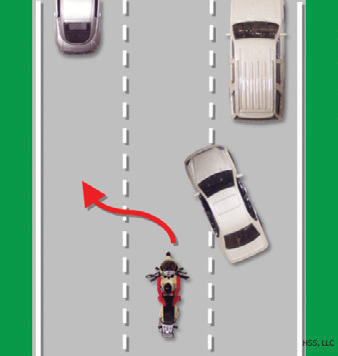
All Locations Closed for Christmas & New Years
All locations closed Thurs-Fri Dec 25-26 & Thurs 1 Jan.
Section 6: Roadway Management
Section 6: Roadway Management
This Section Covers
- Crash Avoidance – 6.1
- Cornering – 6.2
- Sharing the Road with Commercial Vehicles – 6.3
On the road, situations change constantly. As a responsible rider, you know how important it is to be in full control of the motorcycle. A responsible rider knows that good road management starts with knowledge and practice of SEE.
6.1 – Crash Avoidance
No matter how careful you are, there will be times when you find yourself in a difficult spot. Your chances of avoiding a crash and possible injury will depend on your ability to react quickly and properly. Two critical crash avoidance skills you will need to learn and practice are stopping quickly and swerving.
Stopping Quickly
Stopping a motorcycle quickly and safely is a skill that requires a lot of practice.
This is accomplished by applying controlled pressure to both the front and rear brakes at the same time without locking either wheel.
To do this:
- Squeeze the front brake lever and apply pressure to the rear brake pedal at the same time. Do not apply maximum pressure to the front brake lever and rear brake pedal all at once. Gradually increase pressure to the front brake lever as weight is transferred forward to the front tire.
- Keep your knees against the tank and your eyes up, looking well ahead. Good riding posture will help you stop the motorcycle in a straight line.
- If the front wheel locks up, release pressure on the front brake lever to get the tire rolling, then immediately reapply with controlled gradual pressure.
- If the rear wheel locks up, keep it locked until you have come to a complete stop. Maintain pressure on the rear brake pedal and keep your knees against the tank and your eyes up. You can still bring the motorcycle to a controlled stop in a straight line if the rear wheel locks up.
Stopping Quickly in a Curve
If you must stop quickly while turning or riding in a curve, the best technique is to straighten the motorcycle, square the handlebars and then stop. There may be conditions that do not allow straightening first, such as running off the road in a left-hand curve or dealing with oncoming traffic in a right-hand curve. In such situations, apply the brakes smoothly and gradually. As you slow, reduce your lean angle and apply more brake pressure until the motorcycle is straight and maximum brake pressure is possible. You should “straighten” the handlebars in the last few feet of stopping; the motorcycle should then be straight up.
Anti-Lock Braking Systems (ABS)
Some motorcycles use this technology to prevent wheel lock-up. If your motorcycle is equipped with anti-lock brakes apply maximum pressure on both the front and rear brakes as quickly and firmly as you can. You may feel a pulsation in the brakes; continue to hold brake pressure until you have completely stopped. Most ABS systems are designed to reduce or prevent wheel lock-up only while riding in a straight line; ABS may not prevent wheel lockup while leaned over in a curve or turn.
Handling Skids
Sometimes a skid cannot be avoided. Here’s what to do:
- Front-Wheel Skids – If the front wheel locks, release the front brake immediately and completely. Reapply the brake smoothly. Front-wheel skids result in immediate loss of steering control and balance. Failure to fully release the brake lever immediately will result in a crash.
- Rear-Wheel Skids – A skidding rear wheel is a dangerous condition, caused by too much rear brake pressure, which can result in a violent crash and serious injury or death. If the rear wheel is skidding, keep the rear brakes applied and the front tire pointed straight ahead, until you have come to a complete stop. Do not release the rear brake.
Rear-Wheel Skids—Proper braking

Rear-Wheel Skids—Excessive braking

Swerving
Swerving to avoid a crash may be appropriate if stopping is not an option. A swerve is any sudden change in direction. Be sure you have enough time and space to swerve. It can be two quick turns or a rapid shift to the side. To swerve:
- Apply firm forward pressure to the handgrip located on the side you want to turn. This will cause the motorcycle to lean quickly. The sharper the turn, the more the motorcycle must lean.
- Press forward on the opposite handgrip once you clear the obstacle to return to your original direction of travel.
- Keep your body upright and allow the motorcycle to lean in the direction of the turn while keeping your knees against the tank and your feet solidly on the footrests.
If braking is required, separate it from swerving. Brake before or after – never while swerving.
Brake, then Swerve

Swerve, then Brake
